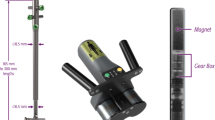Abstract
Introduction
Fractures of the humeral shaft are relatively common injuries and the majority achieve union uneventfully; however, non-union rates of up to 13% are reported when managed either conservatively or operatively. Despite the many surgical techniques described for the management of non-unions, including plate fixation, intramedullary nailing or external fixation, some cases remain resistant to treatment with ongoing problems achieving union.
Method
We describe a technique using the Stryker T2™ humeral nail which incorporates a compression system allowing closure of the non-union fracture gap. Twelve patients underwent compression nailing for established humeral fracture non-union. All achieved radiological union at an average of 4.5 months (range 3–12 months).
Results
All patients reported a return to their normal pre-injury level of activities.
Conclusion
We conclude that this technique of intramedullary nailing with a novel compression technique is effective in the treatment of humeral shaft fracture non-union.




Similar content being viewed by others
References
Sarmiento A, Zagorski JB, Zich GA et al (2000) Functional bracing for the treatment of fractures of humeral Diaphyses. J Bone Joint Surg Am 82:478–486
Ring D, Perey BH, Jupiter JB (1999) The functional outcome of operative treatment of ununited fractures of the humeral diaphyses in older patients. J Bone Joint Surg Am 81:177–190
Green E, Lubahn JD, Evans J (2005) Risk factors, treatment and outcomes associated with nonunion of the midshaft humerus fracture. J Surg Orthop Adv 14(2):64–72
Healy WL, White GM, Mick CA et al (1987) Nonunion of the humeral shaft. Clin Orthop 219:206–213
McKnee MD, Miranda MA, Riemer BL et al (1996) Management of humeral nonunion after failure of locking intramedullary nails. J Orthop Trauma 10:492–499
Pritchett JW (1985) Delayed union of humeral shaft fractures treated by closed flexible intramedullary nailing. J Bone Joint Surg Br 67:715–718
Barquet A, Fernandez A, Luvizio J et al (1989) A combined therapeutic protocol for aseptic nonunion of the humeral shaft. J Trauma 29:95–98
Chen CY, Ueng SW, Shih SH (1997) Staged management of infected humeral nonunion. J Trauma 43:793–798
Loomer R, Kokan P (1976) Nonunion in fractures of the humeral shaft. Injury 7:274–278
Lin J, Chiang H (2002) Chang DS: locked nailing with interfragmentary wiring for humeral nonunions. J Trauma 52:733–738
Dawson J, Fitzpatrick R, Carr A (1996) Questionnaire on the perceptions of patients about shoulder surgery. J Bone Joint Surg Br 78(4):593–600
Constant CR, Murley AH (1987) A clinical method of functional assessment of the shoulder. Clin Orthop Relat Res 214:160–164
Yian EH, Ramappa AJ et al (2005) The Constant score in normal shoulders. J Should Elbow Surg 14(2):128–133
Blum J, Machemer H, Hogner M et al (2000) Biomechanics of interlocked nailing in humeral shaft fractures: comparison of two nail systems and the effect of interfragmentary compression with unreamed humeral nail. Unfallchirurg 103:183–190
Patel VR, Menon DK, Pool RD et al (2000) Nonunion of the humerus after failure of surgical treatment: management using the Ilizarov frame. J Bone Joint Surg (Br) 82-B:977–983
Wu CC (1996) Humeral shaft Nonunion treated by seidel interlocking nail with supplementary staple. Clin Orthop 326:202–208
Richardson T, Voor M, Selingson D (1998) Fracture site compression and motion with three types of intramedullary fixation of the femur. Osteosynthese Int 6:261–264
Pietu G, Raynaud G, Letenneur J (1994) Treatment of delayed and nonunions of the humeral shafts using the Seidel locking nail. J Orthop Trauma 8:240–244
Lin J, Hou SM, Hang YS (2000) Treatment of Humeral shaft delayed unions and nonunions with humeral Nails. J Trauma 48(4):695–703
Marti RK, Verheyen CC, Besselaar PP (2002) Humeral shaft nonunion: evaluation of uniform surgical repair in fifty-one patients. J Orthop Trauma 16(2):108–115
Volgas D, Stannard J, Alonso J (2004) Nonunions of the humerus. Clin Orthop 419:46–50
Kesemenli CC, Subasi M, Arslan H et al (2002) Treatment of humeral diaphyseal non-unions by interlocked nailing and autologous bone grafting. Acta Orthop Belg 68(5):471–475
Lammens J, Bauduin G, Driesen R et al (1998) Treatment of nonunion of the humerus using the Ilizarov external fixator. Clin Orthop 353:223–230
Muller ME (1965) Treatment of nonunions by compression. Clin Orthop 43:83–92
Mückley T, Diefenbeck M, Sorkin AT et al (2008) Results of the T2 humeral nailing system with special focus on compression interlocking. Injury 39:299–305
Ranieri L, Olmi R (1976) Nonunion of the humerus after internal fixation. Ital J Orthop Traumatol 2:51–55
Mueckley T, Gonschorek O, Buehren V (2003) Compression nailing of long bones. Eur J Trauma 29:113–128
Verbruggen JP, Sternstein W, Blum J, Rommens PM, Stapert JW (2007) Compression-locked nailing of the humerus: a mechanical analysis. Acta Orthop 78(1):143–150
Khan MS, Sahibzada AS, Khan MA et al (2005) Outcome of plating, bone grafting and shortening of humeral diaphyseal fracture. J Ayub Med Coll Abottabad 17(2):44–46
Kontakis GM, Papadokostakis GM, Alpantaki K et al (2006) Intramedullary nailing for non-union of the humeral diaphysis: a review. Injury 37(10):953–960
Dimitriou R, Dahabreh Z, Katsoulis E et al (2005) Application of recombinant BMP-7 on persistent upper and lower limb non-unions. Injury 36(Suppl 4):S51–S59
Yajima H, Maegawa N, ota H et al (2007) Treatment of persistent non-union of the humerus using a vascularized bone graft from the supracondylar region of the femur. J Reconstr Microsurg 23(2):107–113
Conflict of interest statement
The authors declare that they have no conflict of interest.
Author information
Authors and Affiliations
Corresponding author
Rights and permissions
About this article
Cite this article
Fenton, P., Qureshi, F., Bejjanki, N. et al. Management of non-union of humeral fractures with the Stryker T2™ compression nail. Arch Orthop Trauma Surg 131, 79–84 (2011). https://doi.org/10.1007/s00402-010-1110-7
Received:
Published:
Issue Date:
DOI: https://doi.org/10.1007/s00402-010-1110-7




